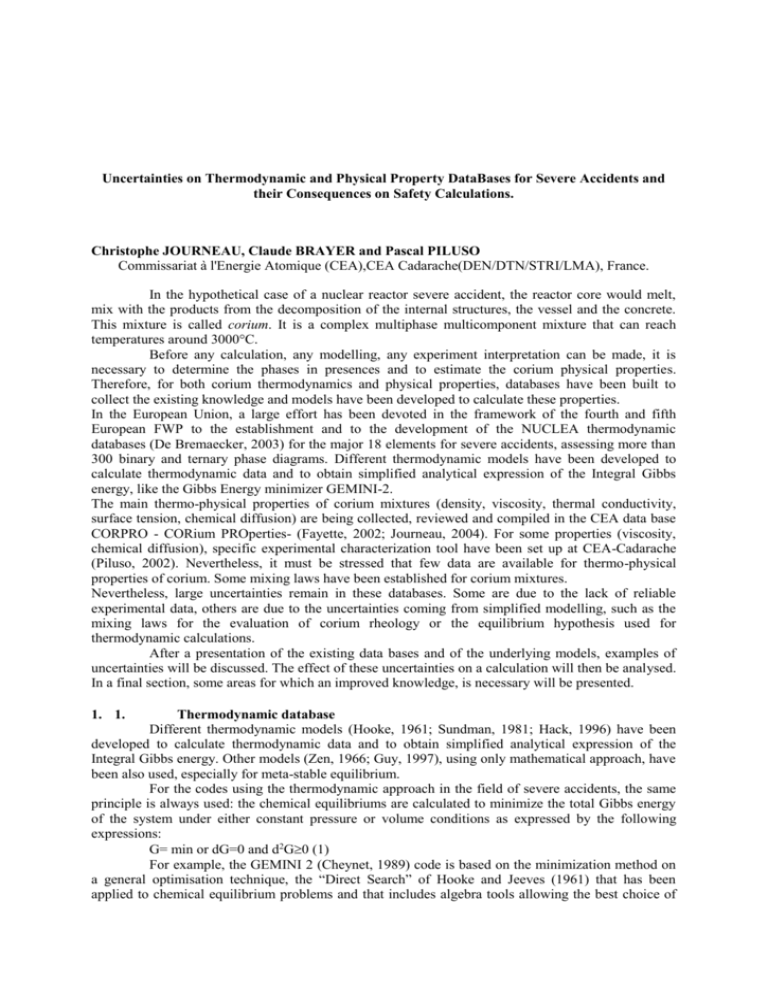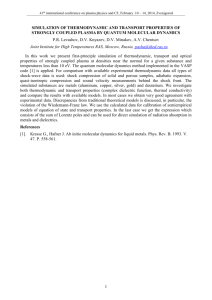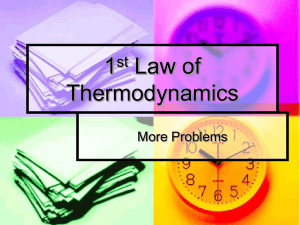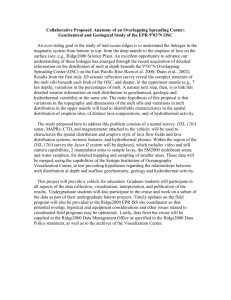Uncertainties on Thermodynamic and Physical Properties
advertisement

Uncertainties on Thermodynamic and Physical Property DataBases for Severe Accidents and their Consequences on Safety Calculations. Christophe JOURNEAU, Claude BRAYER and Pascal PILUSO Commissariat à l'Energie Atomique (CEA),CEA Cadarache(DEN/DTN/STRI/LMA), France. In the hypothetical case of a nuclear reactor severe accident, the reactor core would melt, mix with the products from the decomposition of the internal structures, the vessel and the concrete. This mixture is called corium. It is a complex multiphase multicomponent mixture that can reach temperatures around 3000°C. Before any calculation, any modelling, any experiment interpretation can be made, it is necessary to determine the phases in presences and to estimate the corium physical properties. Therefore, for both corium thermodynamics and physical properties, databases have been built to collect the existing knowledge and models have been developed to calculate these properties. In the European Union, a large effort has been devoted in the framework of the fourth and fifth European FWP to the establishment and to the development of the NUCLEA thermodynamic databases (De Bremaecker, 2003) for the major 18 elements for severe accidents, assessing more than 300 binary and ternary phase diagrams. Different thermodynamic models have been developed to calculate thermodynamic data and to obtain simplified analytical expression of the Integral Gibbs energy, like the Gibbs Energy minimizer GEMINI-2. The main thermo-physical properties of corium mixtures (density, viscosity, thermal conductivity, surface tension, chemical diffusion) are being collected, reviewed and compiled in the CEA data base CORPRO - CORium PROperties- (Fayette, 2002; Journeau, 2004). For some properties (viscosity, chemical diffusion), specific experimental characterization tool have been set up at CEA-Cadarache (Piluso, 2002). Nevertheless, it must be stressed that few data are available for thermo-physical properties of corium. Some mixing laws have been established for corium mixtures. Nevertheless, large uncertainties remain in these databases. Some are due to the lack of reliable experimental data, others are due to the uncertainties coming from simplified modelling, such as the mixing laws for the evaluation of corium rheology or the equilibrium hypothesis used for thermodynamic calculations. After a presentation of the existing data bases and of the underlying models, examples of uncertainties will be discussed. The effect of these uncertainties on a calculation will then be analysed. In a final section, some areas for which an improved knowledge, is necessary will be presented. 1. 1. Thermodynamic database Different thermodynamic models (Hooke, 1961; Sundman, 1981; Hack, 1996) have been developed to calculate thermodynamic data and to obtain simplified analytical expression of the Integral Gibbs energy. Other models (Zen, 1966; Guy, 1997), using only mathematical approach, have been also used, especially for meta-stable equilibrium. For the codes using the thermodynamic approach in the field of severe accidents, the same principle is always used: the chemical equilibriums are calculated to minimize the total Gibbs energy of the system under either constant pressure or volume conditions as expressed by the following expressions: G= min or dG=0 and d2G0 (1) For example, the GEMINI 2 (Cheynet, 1989) code is based on the minimization method on a general optimisation technique, the “Direct Search” of Hooke and Jeeves (1961) that has been applied to chemical equilibrium problems and that includes algebra tools allowing the best choice of variables in all cases. In order to determine the thermo-chemical equilibrium state of a multiphase system at a given temperature, the whole Gibbs Energy of the system is minimized with regard to the independent variables, after having taken into account the constraints of the problem, i.e. the mass balance conservation conditions. Thus, the description of the Gibbs energy, dG, as function of temperature or atomic composition, is needed for all the possible phases. In the framework of the EC Fourth Framework Programme on Nuclear Fission Safety, PK Mason and MA Mignanelli (1999) have compared the use of ideal interaction terms with non-ideal interaction terms to describe the thermodynamic stability of the solution phases and to determine the fission product release. They concluded that in general, same results have been obtained in the two cases even if, in some specific cases, differences have been obtained: stability of condensed phase have been calculated using ideal approach that didn’t exist using non-ideal approach (solution calculation). More recently, PY Chevalier (2004) has developed a new model for the solid solution UO2±x. The old modelling was a simplified model with only one lattice. A new model, closer of the physical crystallographic structure, has been developed using three sub-lattices and the interaction between these 3 sub-lattices. No fundamental differences between the thermodynamic calculation with the old model and the new model have been noted, but this modelling better represents experimental data. These thermodynamic calculations require the calculation of thermodynamical functions (enthalpy, entropy) for the possible constituents (pure compounds, solutions,…) of the system to be computed. Thermodynamic databases have thus been collected and assessed to achieve this goal. For instance, THERMODATA has developed the TDBCR and now NUCLEA (de Bremaecker, 2003) bases for severe accident research. There are currently 18 elements in NUCLEA. Nevertheless, there are still significant uncertainties present in the nuclear thermodynamic data bases. Six cases (reactor casse or R&D cases) have been chosen as representative of severe accidents forthermodynamic calculations. Uncertainties on thermodynamic outputs (liquidus and solidus temperatures, solid, liquid mass fractions during solidification, and enthalpy) have been assessed from the user point of view. Some general rules for the uncertainties are given to help the user of thermodynamic databases in the assessments of its results for corium. The representative cases for severe accidents that have been chosen are: a VULCANO spreading experiment (VULCANO VE-U3 – Journeau, 2003), the TMI2 corium composition in reductive atmosphere, a typical EPR composition, the gaseous substances produced during MCCI, gaseous substances for in-vessel corium and U1-xZrxO2+y hyperstoichiometric compositions. From the thermodynamic calculations of these six cases, some general rules for the uncertainties can be advocated to help the user of thermodynamic databases in the assessments of its results for corium: the thermodynamic outputs uncertainties are decreasing with the latest versions of the databases (see Figure 1), all the thermodynamic outputs don’t have the same uncertainties, for the liquidus and solidus temperatures and for the enthalpy, the uncertainties are getting lower for the successive databases, for the liquid, the uncertainties of the compositions are low, between solidus and liquidus temperatures, the uncertainties are increasing with the nature and the quantities of the existing substances, for the gaseous substances, the uncertainties are increasing with the nature and the quantities of the existing substances (see Figure 2). It’s possible to define a general rule to qualify a thermodynamic calculation in relation with the quality of the binary systems that constitute the corium composition : if all the pseudo-binary systems that constitute the corium composition have been well assessed, it’s possible to have a good confidence that uncertainties on temperature will be less than 50K ; if one or more pseudo-binary systems that constitute the corium composition have a low assessment quality, at least an uncertainty on the temperature of 100 K could be expected. In the U-Zr-O system, it has been demonstrated that the old modelling, without experimental data, had big uncertainties for O/M>2.00. The last modelling is now correct, but this example shows the difficulties to model thermodynamic data without experimental data. It can be very important such that for the system FexOy-ZrO2 where, in the absence of experimental data, the liquidus temperature was overestimated by 600K. Figure 1: Typical EPR concrete liquid fraction Figure 2: Gaseous species at 2573 K in 400 m3 for MCCI (TDBCR 972,981,992, 001). An other work concerns the relevance of subsystems for the nuclear thermodynamic databases. Five research and industrial partners working in the field of severe accidents R&D have been surveyed in the framework of the ENTHALPY project. The objective was to determine the main subsystems of prior interest that they currently use with the Nuclear Thermodynamic Database (NTD in-vessel and ex-vessel). 290 subsystems have been assessed by the end-users of the NTD. For them, 12% of the of the sub-systems are the most important ones. The main elements of the in-vessel corium (U, Zr, Fe, O) belong to the most relevant subsystems which have been chosen. There is currently a good knowledge and modelling of these subsystems except for the subsystems with iron oxides. Among these most relevant systems, it must be stressed that there is currently a good knowledge and modelling of most of these subsystems. For the binary and the ternary systems including iron oxides, there’s a need of reliable thermodynamic data for the end-users of NTD. According to the assessment of Hudon (2002), the UO2-SiO2 pseudobinary, which is the basis for corium-concrete interaction studies, also rely on “doubtful” experimental data from Lundu (1962). Finally, it must be stressed that these calculations are assuming thermodynamic equilibrium, whereas the corium mixture can be out of equilibrium. For instance, some of the TMI-2 samples were metastable tetragonal phases (Brown, 1989). Similar phases have also been found with quantitative Xray diffraction analysis of VULCANO spreads (Piluso, 2005). 2. 2. Physical properties Database Once thermodynamic calculations have provided, for a given temperature, the existing phases in presence, and their proportion, the physical property for all the phases present in the given corium can be estimated. The last step will be the use of appropriate mixing laws to estimate the corium equivalent properties (Journeau, 2004). Substances physical properties have been collected, assessed and databases such as CORPRO (Fayette, …) have been constructed. Whereas a large amount of data exists for UO2., data are often scarce and sometimes incoherent for the other constituents of corium. For example, only two sets of data have been found in the literature for the liquid ZrO2 density, one (Hohorst, 1990) being denser (5990 100 kg.m-3 ) than the solid at melting point, the other (Strizhov, 1995) being lighter (5700 kg.m-3). For molten zirconia, there is thus a definite need for further density experimental data. Figure 3: Density of uranium High temperature data for the metallic phase also present large uncertainties. Figure 3 presents the data for uranium density. It appears that there is a 2000 kg/m3 spread around 2500 K (potential temperature for a corium metal-oxide system in equilibrium) between the data of Grosse (1961) and Boivineau (1993). Mixing laws also present significant uncertainties. For instance, Urbain (1987) and modified Arrhenius (1917) mixing laws has been proposed by Ramacciotti (2001) to estimate of the viscosity of semi-solid silicate corium melt. Although this modelling is satisfactory, only orders of magnitude values can be expected. Due to these uncertainties, the viscosity estimates are often fitted to a simpler law, such as Shaw (1969) correlation, =0exp[A(Tliquidus-T)]. 3. 3. Uncertainties An uncertainty analysis was performed to check if the difference between the experimental and the calculated lengths can be explained by the uncertainties on the physical properties and experimental results, or by the uncertainty in the model parameters and assumptions. Hence, this uncertainty study pointed out the influence of each parameter on the calculation results; revealing the more or less important parameters, it constitutes also a sensitivity study. The VULCANO VEU1 spreading test (Journeau, 2003), involving prototypic corium with urania has been chosen for this analysis. Spreading is modelled by the THEMA code (Spindler, 2004). As in these experiments the width is small compared to the length, 1D grids were used. Before the study itself, some calculations were performed to test the dependency of the results on the spatial discretization. Two mesh sizes were tested, giving similar results (fig. 90) and allowing us to use the rougher mesh for the succeeding calculations. This mesh is composed of sixteen 2.5 cm long cells and thirty five 5 cm long cells, the small cells being near the inlet. These first calculations performed with the V2.2mod1c code version and with the "best estimate" parameters recommended by the experimental team and by the developers, showed, for the VEU1 test, a good agreement of the calculated length with respect to the experimental one. The simultaneous influence of more than 11 parameters was tested in term of global effects. This means that calculations were performed with 2 values of each parameters, the lower and the upper value. The test of all the possible interactions between all the 11 parameters required a complete calculation map, consisting of 211 ( = 2048) different calculations. This too high number of calculations imposed the use of a reduced calculation map. The number of calculations in this reduced map, 128, was chosen in order to have a confidence and a quality level, as defined by Wilk's formulation, greater than 0.96. This map was built in a way to avoid any correlation between 2, 3, 4, and 5 parameters. The sensitivity studies were carried out for each of the two chosen VULCANO tests and with two different versions of THEMA, V2.2mod1c and the latest released version, V2.3mod6. The main differences between these two versions are for THEMA V2.3mod6 a better modelling of the upper heat transfer, a better modelling of the contact resistance between the spread and the substratum, and some corrections in the solidification heat when the solidification temperature differs from Tsolidus. With THEMA V2.2mod1c, only the influence of the parameters on the spreading length was tested. With the other version, the influence of the parameters on other results such as crust thicknesses or temperatures was also tested. In this study the melt viscosity in the mushy zone was described by the Shaw correlation, =0exp[A(Tliquidus-T)], in which the influence of the parameters 0 and A are tested. The tested parameters were : the 0 coefficient of the Shaw correlation, the A coefficient of the Shaw correlation, the melt liquidus temperature (THEMA V2.2mod1c only), the initial melt temperature, the assumption for the inlet flow rate, low flow rate or high flow rate, the surrounding temperature (THEMA V2.2mod1c only), the melt emissivity (THEMA V2.3mod6 only), the solidification model, bulk freezing or combined bulk and crust solidifications (THEMA V2.2mod1c only), the solidification temperature of the crust, varying between T solidus and the temperature corresponding to a weight solid fraction of 50%. (THEMA V2.3mod6 only), the transport or no transport of the upper crust. (THEMA V2.3mod6 only), the melt density (THEMA V2.2mod1c only), the melt thermal conductivity, the melt heat capacity, the contact thermal resistance between the spread and the substratum, the substratum thermal conductivity (THEMA V2.3mod6 only). The modification of the melt liquidus temperature or the choice between the two solidification models, directly in the data files, were possible with the V2.2mod1c version only. These parameters were then not checked with THEMA V2.3mod6. The combined bulk and crust solidification model is the only solidification model available with THEMA V2.3. Therefore, the freezing model parameter was replaced by the study of the solidification temperature which appears in the bulk and crust freezing model. The parameters used in the study of the VE-U1 experiment are detailed in Table I. Table I: Parameters used in the study of the VE-U1 test values of the studied parameters parameter 0 Shaw correlation coefficient A Shaw correlation coefficient melt liquidus temperature, Tliquidus (K) initial melt temperature (K) assumption for the inlet flow rate surrounding temperature (K) melt emissivity solidification model solidification temperature (K) transport of the upper crust melt density (kg/m3) melt thermal conductivity (W/m/K) melt heat capacity therm. resist. with substratum (K.m2/W) substratum thermal conduct. (W/m/K) low value 0.021 0.01 2175 2015 high flow rate 300 0.6 bulk freezing high value 0.034 0.024 2325 2185 low flow rate 700 1 crust and bulk 1300 2000 no yes std. values ±250 or ±500 (depend. on T) 1 5 std. values ±10 % 0 0.006 0.8 1.4 parameter used if not studied V2.2mod1c V2.3mod6 studied studied studied studied studied 2250 studied studied studied studied studied 300 0.8 studied studied crust and bulk 1300 studied no studied studied std. values studied studied studied studied studied studied 1.1 studied These parameters were varied between the low and the high uncertainty boundaries for the physical or for the experimental parameters or between the available models, for the code parameters. The solidification temperature used in the combined bulk and crust freezing model, for the study performed with THEMA V2.2mod1c, is equal to Tsolidus, 1300 K. Two calculations were added to the calculation map with the two inlet flow rates and with the best estimate parameters. These parameters are reported in Table II. Table II: Best estimate parameters for the VE-U1 test parameter 0 Shaw correlation coefficient A Shaw correlation coefficient melt liquidus temperature, Tliquidus (K) initial melt temperature (K) surrounding temperature (K) melt emissivity solidification model solidification temperature (K) transport of the upper crust melt density (kg/m3) melt thermal conductivity (W/m/K) melt heat capacity therm. resist. with substratum (K.m2/W) substratum thermal conduct. (W/m/K) best estimate value 0.037 0.024 2250 2100 300 0.8 bulk and crust 2000 no std. value 3.5 std. values 0.006 1.1 The spreading lengths obtained with the two THEMA versions agree well with the experimental spreading length (see Figure 4). Figure 4: THEMA calculations of the VE-U1 test spreading lengths a: THEMA V2.2mod1c calculations b: THEMA V2.3mod6 calculations The correlation coefficients between the calculated spreading lengths and the parameters are reported on Figures 5 and 6. Figure 5: Correlation coefficients between the parameters and the spreading lengths calculated for the VE-U1 test with THEMA V2.2mod1c Figure 6: Correlation coefficients between the parameters and the spreading lengths calculated for the VE-U1 test with THEMA V2.3mod6 The parameter which is the more correlated to the spreading length is the flow rate, especially at the beginning of the spreading process. The other influent parameters are the A coefficient, the liquidus temperature and the inlet temperature. The melt conductivity has also an influence on the spreading length, increasing with time. The other parameters are weakly correlated to the spreading length. In the VE-U1 test, the substratum being equipped with thermocouples, the temperature evolutions calculated (with THEMA V2.3mod6) at two thermocouple locations, the first one at the substratum surface and at 13 cm from the inlet and the second in the substratum, 1 cm under the first one, were compared to the experimental records (see Fig 7). Figure 7: Comparison of temperature evolutions measured in the VE-U1 test and calculated with THEMA V2.3mod6. a : Temperature evolution at the substratum b : Temperature evolution 1 cm under the surface, 13 cm from the inlet substratum surface at 13 cm from the inlet These figures show that the temperatures calculated with the best estimate parameters are lower than the experimental ones. This difference can be explained by the fact that the best estimate calculation were performed with the highest thermal resistance, 0.006 K.m2/W, which has, as it can be seen below, a large impact on the substratum temperature. The experimental temperatures are also between the lower and the higher calculated temperatures. The correlation coefficients between these temperatures and the different parameters have also been computed, they are reported in Figure 8. Figure 8: Correlation coefficients interface temperature substratum (VE-U1 test) The parameters which are the most correlated to the temperature at the substratum surface are the thermal resistance between substratum and melt, the melt conductivity and the inlet temperature. The A coefficient, the substratum conductivity and the flow rate have also some influence on the temperature of the substratum surface. The parameters which are the most correlated to the substratum temperature 1 cm under the surface are the substratum conductivity, the thermal resistance between substratum and melt, the melt conductivity, the flow rate and the inlet temperature. The upper crust transport and the A coefficient have also some influence on this substratum temperature. The substratum conductivity is negatively correlated to the surface temperature and positively correlated to the substratum temperature. The influence of the uncertainty of up to 14 parameters (physical properties, experimental conditions, or model assumptions) on the computed results was tested. The correlations between results and parameters were also calculated. It appears that the spreading length measured in the VE-U1 test is well described by THEMA. The calculation of the correlation coefficients pointed out that the prevailing parameters for the spreading lengths are the liquidus temperature, the A coefficient of the Shaw correlation, the initial melt temperature, the melt flow rate, and the melt conductivity. The less influent parameters are the surrounding temperature, the corium emissivity and the substratum conductivity. The VE-U1 temperatures at the substratum surface or 1 cm below, calculated with the best estimate parameters, are below the experimental values because these calculations were performed with the highest thermal contact resistance. However the measured values are between the lower and the upper calculated temperatures. The correlation coefficients calculated between the parameters and the substratum temperatures show that the substratum surface temperature evolution depends on the thermal resistance, the melt conductivity, the initial melt temperature and to a lesser extent, on the A coefficient, on the substratum conductivity and on the melt flow rate. On the other hand, the substratum temperature evolution, 1 cm under the surface, mainly depends on the melt and substratum conductivities, the thermal resistance (mainly at the end of the spreading process), the melt flow rate (mainly at the beginning of the spreading process) and the initial melt temperature. The impact of the heat transfer model between the melt and the lower crust has not been studied. It may however have some influence on the substratum temperatures. 4. 4. Needs for improved knowledge Currently, with the large progresses made in the understanding of severe accident phenomenology, the uncertainties in the thermodynamic and physical properties of corium mixtures are an important part of the overall uncertainties in severe accident calculations. Sensitivities analyse, such as the one described in the previous section is an useful tool to determine the properties on which the focus shall be made for further research. For spreading, viscosity is clearly the properties with the largest unknown. The properties of some constituents of liquid corium (such as molten zirconia) need experimental work. Mixing laws also require a better knowledge, in particular for the thermal conductivities, for which no applicable mixing law is available for mixtures and solutions. Even if uncertainties in the physical property estimation are set to an acceptable level, the prior thermodynamic calculations must remain with small uncertainties. Large progresses have been made in the last ten years but the effects of iron and silicon oxides on corium mixture phase diagrams have still to be studied in order to reduce uncertainties. Acknowledgement The works reported in this paper were mainly performed within the CSC, ECOSTAR and ENTHALPY projects of the European Commission 4th and 5th Frameworks programmes for Research and Training. References Arrhenius, S., 1917. The viscosity of solutions. Biochem. J. 11, 112–133. Boivineau, M., Arlès, L., Vermeulen, J.-M., Thévenin, T., 1993, High-pressure thermophysical properties of solid and liquid uranium, Physica B 190: 31-35 Brown, A., McIntyre, G.J., Gräslund, C. 1989, Nucl. Technol.180 (1). Chevalier, P.Y., Fischer, E., Cheynet, B., 2004, Progress in the thermodynamic modelling of the O-UZr ternary system, Calphad, 28, 15-40. Cheynet, B., 19889, Complex Chemical Equilibria Calculations with the THERMODATA System, Computer Software in Chemical and Extractive Metallurgy, Ed. by W.T. Thomson, Pergamon Press, New York, pp. 31-44. De Bremaecker, A., Barrachin, M., Jacq, F., Defoort, F., Mignanelli, M., Chevalier, P.Y., Cheynet, B., Hellmann, S., Funke, F., Journeau, C., Piluso, P., Marguet, S., Hozer, Z., Vrtilkova, V., Belovsky, L., Sannen, L., Verwerft, M., Duvignaud, P.-H., Mwamba, K., Bouchama, H., Ronneau, C., European Nuclear Thermodynamic Database for In- & Ex-Vessel applications (ENTHALPY). In: Proc. Symposium FISA 2003, EU Research in Reactor Safety, Luxembourg, 10-12/11/2003. Drottning, W.D., 1982, Density and thermal expansion of liquid U-Nb alloys, High Temp. High Pres. 14, 253-258. Fayette S., Piluso P., novembre 2002 « Conductivité thermique des oxydes à moyennes et haute températures », Congrès « MFHT –1 »-session propriétés physiques, -Aix-en-Provence Grosse, A.V, Kirshenbaum, 1963, The densities of liquid iron and nickel and an estimate of their critical temperature, J. Inorg. Nucl. Chem., 25: 331-334 Guy, B., Pla, J.M., 1997, “Zen +k”: a computer code for phase diagram prediction on a new multidimensional approach, Calphad XXVI, University of Florida, T. Anderson editor, May 1116,1997. Hack, K, 1996, The SGTE Casebook - Thermodynamics at work, The Institute of Materials, London, U.K. Hudon, P., Baker, D. R., 2002, The nature of phase separation in binary oxide melts and glasses. I. Silicate systems, J. Non-cryst. Solids, 303, 299-345. Hohorst, J. K., 1990, SCDAP/RELAP5/MOD3 code Manual Volume 4: MATPRO – A Library of Materials Properties for Light Water Reactor Accident Analysis, EG&G Idaho Report NUREG/CR 5273. Hooke, R., Jeeves, T.A., 1961, Direct Search" Solution of Numerical and Statistical Problems, Journal of the Association for Computing Machinery, 8, 212-229. Journeau, C., Boccaccio, E., Brayer, C., Cognet, G., Haquet, J.-F., Jégou, C., Piluso, P ., Monerris, J., 2003, Ex-vessel corium spreading : results from the VULCANO spreading tests, Nucl. Eng. Des., 223, 75-102. Journeau, C., Piluso, P., Frolov, K.N., 2004, Corium Physical Properties for Severe Accident R&D, ICAPP’04, Int Congr. Advances Nucl. Power Plants, Pittsburgh, PA, June 13-17,2004. Lloyd, L.T., Barret, C.S., 1966, Thermal expansion of alpha Uranium, J. Nucl. Mater., 18: 55-59. Lungu, S.N., 1962, Acad. Rep. Pop. Rom., Stud. Cercet. Fiz.13, 739 Mason, P.K., Mignanelli, M.A, Thermochemical Modelling and Data: Model development and calculations-Final report, EXV-THMO (99)-P017, March 1999. McClelland M.A., Sze J.S., 1995, Surface tension and density measurements for indium and uranium using a sessile-drop apparatus with glow discharge cleaning, Surface Sci. 330: 313-332. Piluso, P., Monerris, J., Journeau, C. Cognet, G., Viscosity measurements of ceramic oxides by aerodynamic levitation, Int. J. Thermophys.23 (5) 1229-1240, 2002. Piluso P., Trillon G., Journeau C., 2005, The UO2-ZrO2 system at high temperature (T>2000K): importance of the meta-stable phases under severe accident conditions, J. Nucl. Mat. 344, 259–264. Ramacciotti, M., Journeau C., Sudreau F., Cognet G., 2001, Viscosity models for corium melts, Nucl. Eng. Design 204, 377-389. Rohr WG, Wittenberg LJ, 1970, Density of liquid uranium, J. Phys Chem 74:1151-1152. Shaw, H.R., 1969, Rheology of basalt in the melting range, J. Petrol. 1à, 510-535. Sheldon, R.I., Mulford, R.N.R.1991, Correction to the uranium equation of state, J. Nucl. Mater. 185: 297-298. Shpil’rain, E.E., Fomin, V.A, Kachalov, V.V, 1988, Density and Surface tension of molten uranium, High Temperatures, 26(5) 690-7. Spindler, B., Veteau, J.-M., Simulation of spreading with solidification: assessment synthesis of THEMA Code, Report CEA-R-6053. Strizhov, V., Voltchek, A., Ozrin, V., Yamshchikov, D., Likhansky, V., Khoruzhii, O., Moskovchenko ,A.; “Property data base that used in calculation”, OECD/RASPLAV Report (1995). Sundman, B., Agren, J., 1981, A regular solution model for phases with several components and sublattices suitable for computer application, J. Phys. Chem. Solids, 42, 297-301. Touloukian, Y.S. et al. 1975, Thermophysical Properties of Materials, vol. 11, IFI/Plenum, New York. Urbain, G., 1987, Viscosity estimation of slags, Steel Res. 58: 11-116 Zen, E-A, 1966, Construction of pressure-temperature diagrams for multi-component systems after the method of Shreinemakers, a geometric approach, US Geol. Survey Bull., 1225.









